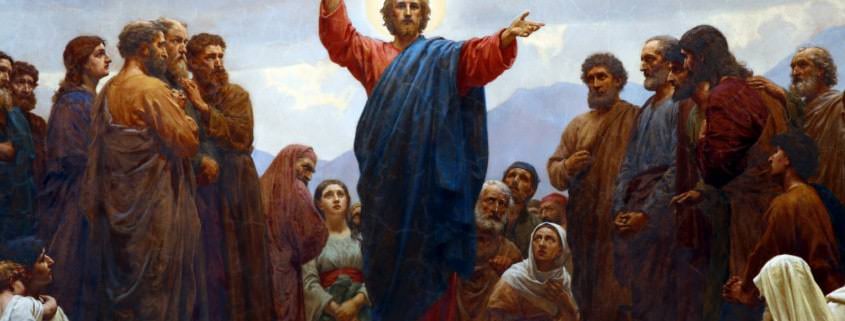The Gospels
An introduction to the Gospels might prove fruitful for you. As you will have seen by now, context is very important when reading the Bible. If we don’t know what it meant to those at the time it was written, we don’t know what it meant at all! It is a very recent idea that we should read the Bible and then come to the conclusion of ‘what it means to me’. There is nothing wrong with that if you know ‘what it means’ first. Whatever it means is then what it means to you as well. This is most important. The Bible will never mean what we think it means. It means something outside of us and it’s our job to find out what as best we can.
The gospels are the first four books of the New Testament. They’re not called the ‘gospels’ by themselves but were given that name, which means ‘good news’. They are four witnesses of the truth about Jesus. There are differences in them and similarities. In court, if all the witness’s stories were identical, their authenticity would be questioned. Each author tells the bios of Jesus in their own way, emphasising specific details.Matthew, Mark and Luke are strikingly similar. They are referred to as the Synoptic gospels (a view together). John’s gospel stands by itself as rather different in focus.
Before the Gospels were written the accounts were all oral and the most important stories were spoken over and over again preserving their accuracy. Once written down from their own angle they tell us the eyewitness account of what Jesus said and did. Matthew tells us about Jesus Christ as the King. Mark tells us about Jesus Christ as the servant. Luke zooms in on Jesus’ humanity and John tells us plainly – Jesus is the Son of God. All of them put us into the context, revealing all the most important information about the life of Jesus Christ. The Gospels are God’s presentation of what we need to know about His Son, the Lord Jesus Christ.
There are many good background books out there with plenty of detail on the gospels. This introduction won’t go into such detail. Below are a few details and hints that will help you as you are reading the gospels. The inter-testamental detail about who the Pharisees are etc. will also make the text come alive in a richer way.
What we are reading is actual history
Lately there are attacks on the authenticity of the Gospels. But Jesus was a real man. He lived in the history of the world. Other historians (Tacitus, Suetonius and more) attest to this fact. Make no mistake, these are historical, real facts we are reading here.
The gospels are full of teaching and narrative
At times we are being told what Jesus and the other characters did. The teaching from these situations is inferred. Then at other times the teaching is direct – we are told exactly what we are to know as though Jesus were teaching us directly. A helpful hint in this regard is to make sure that you are aware of ‘who is talking to who’. You will notice sometimes Jesus is talking to the Pharisees, at times the disciples alone, other times the crowd. This context does make a big difference to the reading and understanding.
How to deal with the parables
Jesus was famous for talking in parables. They are very simple stories and generally the meaning is very easy to understand. People tend to read more into parables than is necessary and warranted. The parables can mean only one thing, or at most two teachings come from a parable.
For example, the complicated story of the virgins in Matthew 25 has been taken to mean all sorts of things about the Holy Spirit. The teaching of the parable is most probably only one thing – to be ready. Just like the bride had to be ready because she didn’t know when the groom would arrive according to custom, be ready at all times for Jesus’ coming! You will be tempted to sleep and get lazy. Don’t! Be ready! And that’s it!
A brief overview of Jesus’ life and ministry
If you put the Gospels together this is the basic story of the life of Jesus:
-
The Birth and childhood of Jesus
The gospels detail all that is necessary to know about his birth and upbringing. Jesus was born in obscurity – a little town called Bethlehem. There are only a handful of events recorded about his early life. Shepherds and wise men visited him. Herod tries to take his life and at a young age Jesus is found in the temple learning the Scriptures and talking with leaders about the Father. This period is about 30 years long.
-
Jesus’ preparation for ministry
Just before he started his public ministry, Jesus is baptised by John. The Holy Spirit anoints him and he is tempted in the wilderness. All three synoptic gospels record these events.
- Jesus’ first year in ministry
The early part of Jesus’ first year of ministry is exclusively covered by the gospel of John and can be found in John 1:19 – 4:42. After Jesus’ temptation he made initial contact with five of his disciples in the area of the desert of Judea. They then went to Cana where they attended a wedding where Jesus turns water into wine – his first miracle.
They then travelled back to Jerusalem to attend the Passover. This would be the first Passover of his public ministry and it would also mark the beginning of the first year of his ministry. There Jesus presented himself to the Jews. He did it by clearing the temple, performing miracles, and teaching. After the Passover he returned to Galilee and on the way witnessed to a Samaritan woman and to her town.
Jesus leaves Nazareth (where he grew up) because he was rejected there when he claimed himself to be the Messiah. Capernaum, a poor town, becomes his base, and for the remainder of His first year of ministry we find Jesus here, enlisting disciples, engaging in preaching tours and performing miracles. This period ends with the second Passover festival mentioned in Luke 6:1-5.
-
The second year of his ministry
Jesus’ second year was particularly fruitful and busy. It ends with his feeding of the five thousand. He designated twelve apostles and sent them out, continued extensive teaching, performed many miracles in and around Galilee.
-
His third year
In the first six months Jesus concluded his Galilean ministry before setting out to minister in Judea for the last six months of his life. A significant turning point in his ministry comes when Jesus challenges the Galilean crowd after feeding the five thousand about their real motives for following and listening to him. The crowd and many followers reject him. His strategy changes from crowd ministry to house to house.
The last six months show Jesus changing his ministry area to Judea and Perea. He visits Jerusalem for the feast of Tabernacles and spends time in and around Jerusalem until his last week.
-
The last week
Six days before the Passover Jesus arrived in Bethany. This would have been on the Saturday, seeing that the Passover and Jesus’ crucifixion was on the Friday. On Sunday morning Jesus rode into Jerusalem on a donkey where a large crowd shouting his praise met him. On Tuesday, Jesus disputed with the Jewish religious leaders for the last time. He openly refuted their objections and therefore sent them away silenced. There’s no reference to anything happening on the Wednesday in the Gospels. On Thursday, Jesus ate the Passover meal with his disciples, known as the “Last Supper”. A lot happened that night. After the dinner Jesus went to the garden of Gethsemane to pray. He was arrested there that night. After some illegal trials in front of the Jewish Sanhedrin, Pilate finally succumbed to the pressure exercised on him by the Jews and sentences Jesus to be crucified. Jesus hung on the cross for about six hours before he cried out, “It is finished” and he breathed his last.




Leave a Reply
Want to join the discussion?Feel free to contribute!